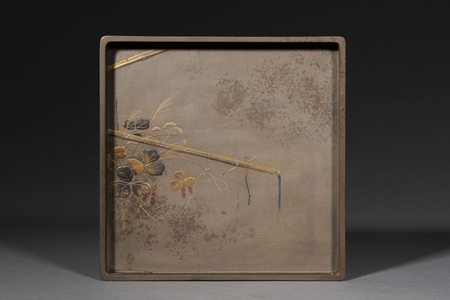Product Description
6603 Ikeda Taishin (1825 – 1930)
A square dry lacquer bon (tray) with a matte shibuichi-nuri ground lacquered with an angled bamboo water gulley and trailing plants in gold, silver and coloured takamakie (raised lacquer) with delicately engraved details.
Signed: Taishin
Japan 19th century Meiji period
Dimensions: 16.3cm x 16.3cm (6½” x 6½”)
Provenance: The Edward Wrangham Collection
Ikeda Taishin (1825-1930) studied both painting and lacquer making under Shibata Zeshin (1807-1891) for many years. Widely considered Zeshin’s most important pupil, Taishin was one of the best-known lacquer artists of the Meiji period. From 1859 he was recognised as an independent makie-shi (professional lacquer artist) and had many pupils including Umezawa Ryushi, the youngest of Zeshin’s three sons. Having won various prizes in Japan and abroad, Taishin became an Imperial Household Artist in 1896. Although he often made large works such as the plaque made for the Chicago World’s Fair in 1893, more typical of his finer works are smaller pieces with traditional decoration.
Works by the artist can be found in the collections of various museums including: Metropolitan Museum of Art, NY, and Tokyo National Museum.







